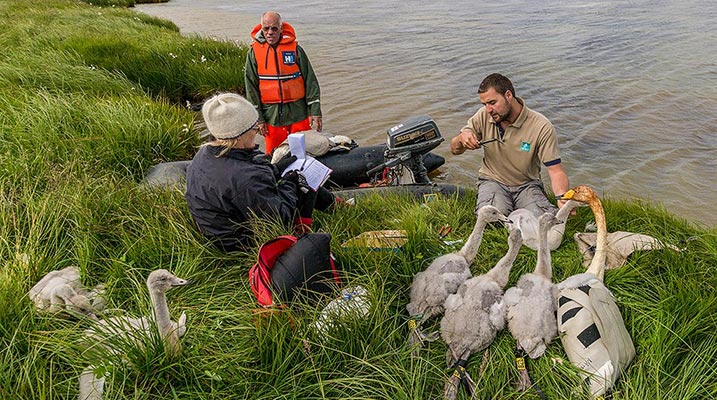Keeping Track of the Whoopers
Whooper swan season has well and truly begun at WWT! Whooper swans undertake probably the longest sea crossing of any swan species, covering between 800 and 1,400 km between Iceland and their wintering sites here in the UK.
Each autumn hundreds of whoopers arrive at WWT Caerlaverock, WWT Martin Mere and WWT Welney. And there, during winter, WWT researchers catch and ring whooper swans as part of our long-term, life-history study on the species. Each bird that’s caught is fitted with a coloured plastic leg ring which is engraved with a unique code large enough to be read at a distance using a scope or binoculars. They’re also fitted with a standard metal ring and various body size measurements and samples are taken to assess its condition and health.

Latest results from winter 2014/15 (assessments conducted in eleven regions across Britain and Ireland) show that a total of 19,434 Whooper Swans were aged (approximately 67% of the total population), with 8,930 birds in England, 2,920 in Scotland, 3,075 in Northern Ireland and 4,509 in the Republic of Ireland. Overall, 20% of birds were cygnets and the average brood size for pairs with young was 2.2 cygnets.
This winter, WWT Martin Mere’s first major influx of whooper swans was at least 112 birds including the first cygnets and the return of Ruby (swan XLM) who was ringed in March and named in commemoration of Martin Mere’s 40th anniversary. Here is WWT Martin Mere’s Reserve manager, Tom Clare, speaking about Ruby.
You can come and find out much more about whooper swans at WWT Caerlaverock, Martin Mere or Welney by asking for one of our swan ID pads when you visit. Using these devices, you can enter any swans’ ring code and colour to find out their life history, whether it's been seen, its name, mate, family, as well as information on how to identify different types of swans and the threats they face.
If that’s not enough, you can also come along and see the whoopers being fed at wild swan feeds at the relevant WWT centres and on Saturday 14 November at WWT Welney we are teaching people how to identify and count different swans in the field to enable them to help us monitor the swan flocks during the winter.
